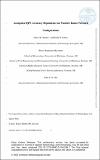Geospatial QPE Accuracy Dependence on Weather Radar Network Configurations
Author(s)
Kurdzo, James M.; Joback, Emily F.; Kirstetter, Pierre-Emmanuel; Cho, John Y
Downloadjamcd190164-1-pre.pdf (12.57Mb)
Publisher Policy
Publisher Policy
Article is made available in accordance with the publisher's policy and may be subject to US copyright law. Please refer to the publisher's site for terms of use.
Terms of use
Metadata
Show full item recordAbstract
The relatively low density of weather radar networks can lead to low-altitude coverage gaps. As existing networks are evaluated for gap-fillers and new networks are designed, the benefits of low-altitude coverage must be assessed quantitatively. This study takes a regression approach to modeling quantitative precipitation estimation (QPE) differences based on network density, antenna aperture, and polarimetric bias. Thousands of cases from the warm-season months of May–August 2015–2017 are processed using both the specific attenuation [R(A)] and reflectivity-differential reflectivity [R(Z,ZDR)] QPE methods and are compared against Automated Surface Observing System (ASOS) rain gauge data. QPE errors are quantified based on beam height, cross-radial resolution, added polarimetric bias, and observed rainfall rate. The collected data are used to construct a support vector machine regression model that is applied to the current WSR-88D network for holistic error quantification. An analysis of the effects of polarimetric bias on flash-flood rainfall rates is presented. Rainfall rates based on 2-year/1-hr return rates are used for a CONUS-wide analysis of QPE errors in extreme rainfall situations. These errors are then re-quantified using previously proposed network design scenarios with additional radars that provide enhanced estimate capabilities. Finally, a gap-filling scenario utilizing the QPE error model, flash-flood rainfall rates, population density, and potential additional WSR-88D sites is presented, exposing the highest-benefit coverage holes in augmenting the WSR-88D network (or a future network) relative to QPE performance.
Date issued
2020-08Department
Lincoln LaboratoryJournal
Journal of Applied Meteorology and Climatology
Publisher
American Meteorological Society
Citation
Kurdzo, James M. et al. "Geospatial QPE Accuracy Dependence on Weather Radar Network Configurations." Journal of Applied Meteorology and Climatology (August 2020): 1–56
Version: Author's final manuscript
ISSN
1558-8424
1558-8432